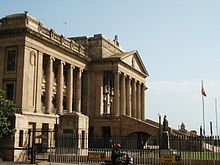President of Sri Lanka
| President of Sri Lanka | |
|---|---|
| Residence | President's House |
| Term length | Six years, renewable once |
| Formation | May 22, 1972 |
| Website | [1] |
 |
|---|
|
|
The President of Democratic Socialist Republic of Sri Lanka is the elected head of state and the head of government. The President is a dominant political figure in Sri Lanka. The office was created in 1978 but has grown so powerful there have been calls to restrict or even eliminate its power. The current President is Mahinda Rajapaksa.
Sri Lanka's executive presidency
At independence, executive power in Ceylon resided with the monarch of Ceylon, represented by the Governor-General, which was exercised on the advice of the Prime Minister. The 1972 constitution replaced the monarch with a president, but that remained a mostly ceremonial position.
The 1978 constitution moved from a Westminster-based political system into one modeled on France. As in France, a new, directly elected President with a longer term and independence from Parliament was created. The President is the commander-in-chief of the armed forces, head of the Cabinet, appoints the prime minister, and could dissolve parliament (after one year has passed since the convening of parliament after a parliamentary election)[citation needed]
In practice, the Sri Lankan presidency was much more powerful than the President of France. French presidents traditionally deal only with defense and foreign policy, leaving domestic affairs to the Prime Minister. Sri Lankan presidents are involved with every aspect of the government and are able to hold ministries, or can bypass the cabinet posts by delegating decisions to the Presidential Secretariat.
Presidents have little constraints on their power and they cannot be taken to court. However they can be impeached by a two-thirds majority in Parliament. They can place the country in a state of emergency, under which they can override any law passed by Parliament[citation needed] and promulgate any regulation without needing legislative approval. However the to prolong the state of emergency for more than a month parliamentary approval is needed.
At the opening of Parliament, the President delivers an address similar to a Speech from the Throne, outlining government policy.
The President has the power to appoint Attorneys-at-Laws to the position of President's Counsel and military personal to the post of Aide de Camp to the President.
In the 1994 election, Chandrika Kumaratunga of the People's Alliance promised to be the last Executive President, bringing in constitutional reforms to return to Westminster-style government. This did not happen during her time in office. While some political parties have expressed their concerns on the executive presidency the abolishment of it is unlikely within the current Sri Lankan political framework
List of presidents
The following is a list of Sri Lankan Presidents. The President is elected under the Sri Lankan form of the contingent vote.
- William Gopallawa
- Junius Richard Jayewardene
- Ranasinghe Premadasa
- Dingiri Banda Wijetunge
- Chandrika Kumaratunga
- Mahinda Rajapaksa
Other information

The official residence of the president is the President's House (formally the Queen's House as the residences of the Governor General) in Colombo. However the president's office is the Presidential Secretariat which at the former Parliament building in Colombo. Other presidential residences include:
- the President's Pavilion, in Kandy, is a presidential residences used for (rare) state functions;
- There is an official presidential vacationing residence in the town of Nuwara Eliya.
In recent years from time to time Prime Minister's House, commonly referred to as Temple Tree's, which has been the official residence of the Prime Minister since 1948, has been used by presidents.
Last election
Template:Sri Lankan presidential election, 2005
